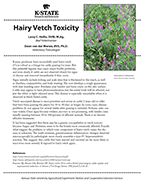Displaying 61 to 70 of 70 Publications
Sweetclover Toxicity
by Larry C. Hollis Deon van der Merwe
MF2950
To prevent sweetclover toxicity, recently damaged plants must not be harvested for hay. Stems of sweetclover plants should be thoroughly dry before being baled as hay. Toxicity is manifested primarily as bruising or bleeding disorders, or lameness. 2-page, color.Published Date: Jan 2011
Forage Facts Notebook
by Paul D. Ohlenbusch Gary L. Kilgore Dale A. Blasi
S115
Grazing & cattle production information. Topics include grasses, legumes, cereals, silage, hay, pasture & soil management, insects, diseases, prescribed burning, weed & brush management.Published Date: Mar 1999
Hairy Vetch Toxicity
by Larry C. Hollis Deon van der Merwe
MF2948
This palatable legume may cause major health problems, and even death in cattle. Signs initially include itching and scaly skin that is thickened to the touch, as well as diarrhea, conjunctivitis, and body wasting. 2 p., color.Published Date: Oct 2010
Grazing Distribution
by Paul D. Ohlenbusch Joseph P. Harner III
MF515
Grazing distribution is the pattern created by livestock grazing rangeland or pasture. Uniform distribution is needed for long-term management & effective use of forage, & protects water sources.Revision Date: Jan 2003
Small Grain Cereals for Forage
by Steve L. Watson Dale L. Fjell James P. Shroyer
MF1072
Small grain cereals (winter wheat, rye, barley, etc.) can be a valuable forage supplement to summer annuals and native grass pastures, and a good primary forage when backgrounding beef cattle.Published Date: Aug 1993
Stocking Rate and Grazing Management
by Paul D. Ohlenbusch Steve L. Watson
MF1118
Grazing management is the art of integrating animals, feed, and other inputs with land, labor, and capital resources.Published Date: Feb 1994
Managing Kansas Grazinglands for Multiple Benefits
by Gary May Larry Huber Will Boyer
MF2086
Plant growth will provide vegetative cover that intercepts rain, impedes runoff, & ensures a root mass that binds soil, reduces leaching of nutrients, animal wastes, pesticides. 20 p.Revision Date: Jun 2004
Prescribed Burning as a Management Practice
by Paul D. Ohlenbusch David C. Hartnett
L815
Burning grassland can recycle nutrients, control weeds & brush, improve grazing distribution, reduce wildfire hazards, improve wildlife habitat, & increase livestock production. 8 p.Revision Date: Mar 2000
How Much Meat to Expect from Your Animal
by Travis O'Quinn et al.
MF3394
Steps in animal processing that affect the weight of the finished product. 2-page, color.Published Date: Feb 2018
Beef Processing Options for Consumers
by Travis O'Quinn et al.
MF3395
How much meat to expect from a beef animal after processing. 4-page, color.Published Date: Feb 2018
Displaying 61 to 70 of 70 Publications
 Sign in
Sign in










